 An expanded version of my Indian Comics Irregular essay A Bearable Brother Bear:
An expanded version of my Indian Comics Irregular essay A Bearable Brother Bear:
 An expanded version of my Indian Comics Irregular essay A Bearable Brother Bear:
An expanded version of my Indian Comics Irregular essay A Bearable Brother Bear:
Disney, the company that gave us Pocahontas, has produced another Native-themed movie: Brother Bear. Here's what critic Roger Ebert said about it (Daily Times, 10/31/03):
'Brother Bear' engaging and cute but lacks zing of 'Finding Nemo'
2003-10-31
by Roger Ebert
Three Indian brothers have their destiny transformed when one is killed by a bear, another is changed into a bear, and the third mistakenly targets his bear-brother for vengeance. Children and their parents are likely to relate on completely different levels, the adults connecting with the artistry and the transfer of souls from man to beast, while the kids are excited by the adventure stuff. Sweet and good-looking, but lacking the zowie factor of "The Lion King" or "Finding Nemo."
The critics largely agreed, but they didn't address whether Brother Bear's Natives seemed authentic or stereotypical. Luckily, that's what we're here for. Let's see what's good and bad about this movie:
Good: The opening narrator, an elder version of the middle brother, speaks Inuit or a similar language.
Bad: None of the characters is voiced by a Native actor. Using the "right" people in an animated movie may seem like a trivial point, but Native voices might have given the characters a distinct cadence or accent, as they did in Pocahontas.
Besides, with rare exceptions (e.g., Robin Williams as Aladdin's genie), people don't go to animated movies for the voices. So why not use Native actors in most or all of the parts?
Good: The lush animation, especially the stunning landscapes. As critic Kenneth Turan put it (LA Times, 10/25/03):
The best thing about "Brother Bear" (directed by Aaron Blaise and Robert Walker) is the richness and fluidity of its visuals, a painterly look that was inspired in part by the classic 19th century canvases of Albert Bierstadt. Set in an Edenic Pacific Northwest some 10,000 years in the past, "Brother Bear's" world of lush waterfalls and verdant forests is one we'd like to vacation in forever.
Good: Tanana, the tribe's "shaman" and apparent leader, is an old woman, suggesting the prominent role of elders and women in many tribes.
Good: All the tribal members look like Inuit-style Natives, yet also like distinct individuals. In particular, the three brothers—Sitka, Denahi, and Kenai—look and act differently. The viewer has no trouble distinguishing them.
Good: The three brothers joke, play, and roughhouse like any brothers might. They're just what we'd consider normal, not stereotypical. They don't speak stoically, commune with nature, or hunt like hit men.
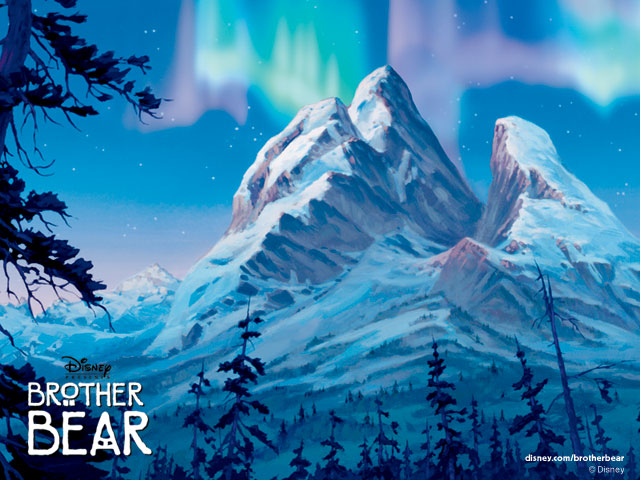
Good: The cultural trappings—fur-lined clothing, kayaks, nets, spears, cave paintings—all seem authentic or appropriate. There are no tipis or chiefs in headdresses here. You might think this would be obvious, but how many thousands of movies, TV shows, books, and comic books have gotten such things wrong?
Bad: The Natives' religion is grossly oversimplified. There are no named gods, only the unnamed "Great Spirits." These spirits, which seem to include the essence of every deceased human and animal, live in the Northern Lights. When these lights touch the mountaintop, the dead can mingle with the living.
This religion doesn't seem to be much more than ancestor worship. Although I don't know the details of Inuit-style religions, I'm pretty sure they're more complicated than this, with a typical pantheon of gods, spirits, and creatures.
If you were doing an overtly Christian film, would you lump God and Jesus together and call them spirits? Probably not. How about presenting a view of Native religion at least as complex as basic Christianity?
We can partly excuse this take on Native religion because the movie is set in the distant past. As the moviemakers might say, we don't know for sure what Native people believed 10,000 years ago. But if the movie had used the tenets of an actual Inuit religion, it would've made a subtle statement: that these people have lived here continuously a long time. That's a statement worth making.
[Spoiler alert: The rest of this review discusses the movie's plot. If you want to be surprised, don't read any further.]
The bear of love?!
Bad: In this movie's conceit, each tribal member gets his or her own animal "totem" in a coming-of-age ceremony. This is more an Anglo, New Age version of Native religion than an authentic one. Some tribes may have a ceremony like this, but most probably don't.
Furthermore, the totems are weirdly specific. It's not just an eagle, wolf, or bear. It's an "eagle of guidance," a "wolf of wisdom," or a "bear of love." No tribe that I know of links an animal to one and only one specific trait.
And the particular traits are weird too. Eagles are usually associated with vision, not the vaguely similar "guidance." You don't think of an older eagle teaching a younger eagle the ropes, do you? No, you think of eagles soaring alone, which contradicts the idea of guiding others.
Similarly, the wolf isn't normally associated with wisdom, but rather with stealth and cunning. In Native lore, the smart animals are the ones who appear to sit back and watch: the raven, the spider, the coyote. One wonders if Disney chose the "wolf of wisdom" simply for its alliteration.
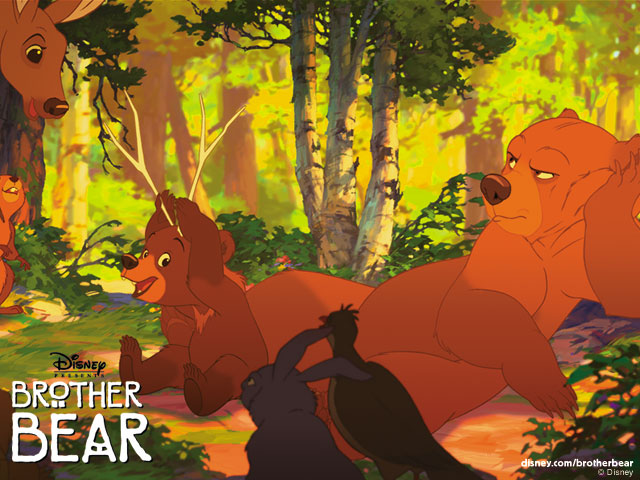
The "bear of love" is even weirder. Most tribes honor the bear for its obvious strength and ferocity. None that I know of honor the bear for its "love." Unlike strength and ferocity, love doesn't help a Native put food on the table. In most tribes, love probably isn't in short supply.
If Natives did want to honor an animal for its loving qualities, the bear isn't the first animal that comes to mind. Or the second or third. What about the wolf again, which mates for life? Or the rabbit, which produces lots of little bunnies? Apparently Brother Bear's creators had fond memories of teddy bears, Winnie the Pooh, or Disney's Bear Country Jamboree.
Clearly, Disney wanted each brother to convey a certain message. Disney also wanted to use the three most prominent animals in Native lore. (Don't hold your breath waiting for a Native movie featuing Hummingbird, Frog, and Mosquito.) So it associated the eagle, wolf, and bear with three qualities usually not associated with those creatures.
Bad: Kenai is upset to receive the "bear of love" as his totem. Incredibly, in this land of bears, the bear isn't an animal to admire and emulate. One wonders which animal the tribe would honor for its strength and ferocity if not the bear.
This leads to confusion that muddles the entire film. Kenai rejects the bear because he thinks it's big and dumb like an overgrown teddy. But later he talks of bears and humans as implacable enemies. Bears are ruthless killers, he says, "monsters."
So which is it? If bears are such killers, why wouldn't Kenai be glad to have one as his totem? Being powerful, fearless, and implacable are exactly the traits people admire in bears. You need such traits to survive in an often harsh environment.
And if bears are such lovable lunks, why does Kenai scorn them to the point of hatred? Why does he think of an innocuous, "dumb" animal as a horrible enemy? Did he have a bad experience with one as a child?
Bad: When a bear eats his fish, Kenai attacks it with rocks. Provoked, the bear understandably fights back. Kenai's brothers come to his aid, and Sitka sacrifices himself to save his siblings.
But the bear survives, and Kenai vows revenge. This flies in the face of the typical Native view of animals as fellow beings. The bear didn't do anything wrong until Kenai provoked it. Despite what Roger Ebert said, it didn't kill Sitka; Sitka chose to die.
I've never heard of Natives seeking revenge against animals. Especially not against animals acting naturally. This Captain Ahab-type syndrome must be rare or nonexistent among Native people.
All bears look the same?
Bad: Kenai gets a lucky break and kills the bear. As some sort of moral scale-balancing, the "Great Spirits" change him into a bear. But not into a duplicate: this bear is smaller and lighter in color.
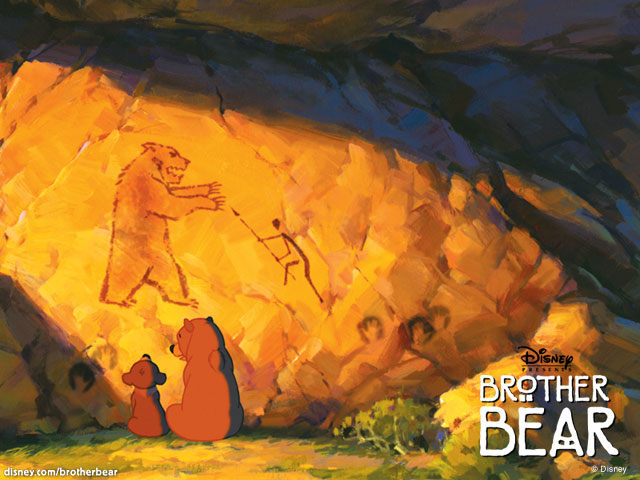
Denahi comes to Kenai's rescue and finds a bear near Kenai's amulet and shreds of clothing. Apparently Denahi assumes the bear that "killed" Sitka also killed Kenai. He also vows revenge.
But Kenai/bear is clearly a different bear to anyone who's paying attention. Why doesn't Denahi realize this? Is he too blinded by hatred? Or maybe he does realize it, but doesn't care. Perhaps the point is that if you dig deep enough, everyone in this tribe is a bear bigot. In other words, no one is willing to let bears be bears and do what bears do naturally.
Good: The characters and their dialogs are a delight, matching the best of Disney's work. The supporting cast of animals almost steals the show. The two moose, Rutt and Tuke, sound just like the MacKenzie Brothers, perhaps because they're voiced by Dave Thomas and Rick Moranis. The two bighorn sheep who challenge their echoes are amusing, and you can even spot a pair of chipmunks a la Chip and Dale.
The movie's moment-to-moment details are impeccable. It's the overall theme and plot that are problematical.
Bad: Kenai the bear meets Koda the bear cub. Koda is a real charmer, perhaps the cutest cub ever. But Kenai takes an instant dislike to him.
Why? Kenai had a close relationship with his brothers. Why would he spurn the company of a pseudo-brother? Nothing in his past indicates any anti-social tendencies.
Because Koda talks and jokes so much? Well, Kenai had the same sort of relationship with his brothers. Koda is probably a lot like Kenai was when he was a boy. It strains credulity that Kenai dislikes Koda so intensely.
Moreover, Kenai is all alone, in a new body, clueless about what to do. Who would be a better guide than a friendly cub? Koda is small enough to be nonthreatening, yet clever enough to be a real aid. Kenai could hardly ask for a better companion.
Think back to all the movies where people switch bodies or places. When you're in a strange new situation, is shunning other people the first thing you do? No, you do the opposite: you gladly accept help from anyone who's sympathetic.
Bad: The animals profess a sort of pan-animal brotherhood common to children's movies. Notably, the bears don't eat anything except fish, who don't seem to have any sentience. The only wolf in sight is an Inuit pet. The eagle doesn't hunt anything and neither does the killer whale. There are no saber-toothed tigers or mountain lions.
The animals seem to fear human hunters, but what about the predators among them? There's no acknowledgment that eagles, wolves, or bears might do the same thing as humans: eat the movie's cute li'l critters as food. This kill-or-be-killed mentality would disrupt or demolish Brother Bear's treacly message of oneness.
Bad: The pan-animal feeling reaches a high point (or perhaps it's a low point) when the bears and moose hitch a ride on the mammoths' backs. This destroys the movie's semi-natural feeling up to this point. We can buy other bits: a staid moose scorning a frolicking bear, echoing voices confusing a bighorn sheep, or bears telling stories to each other in bear language. But we can't buy that a bear or moose would ever ride a mammoth.
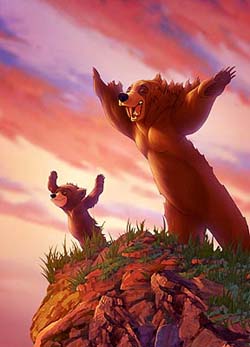
An unbearable message
Bad: Predictably, Kenai learns to like, then love, the irrepressible Koda. But still, he can't forget that bears and humans are supposed to be enemies. Then he meets a whole sloth (or whatever) of bears and, wow, it's a love fest. Kenai sees bears sharing fish, stories, and affections. He realizes they're just like people. He finally understands that love makes the world go 'round.
The only problem is, Kenai already knows this lesson. He was a member in good standing in his tribe and everyone joined him for his ceremony. His brothers clearly loved him and so did Tanana the shaman. There's no obvious lack of love in his life.
The "tribe" of bears teaches Kenai what he already knows—that being part of a community is good. This might be a good lesson if Kenai were a curmudgeon like Ebenezer Scrooge. But Kenai is a companionable brother and friend until he becomes a bear.
So the message seems to be: Don't turn into a bear or you'll become a curmudgeon. You'll have to relearn the lessons you already learned as a human. Namely, the lessons you wouldn't have had to relearn if you hadn't turned into a bear.
Confusing? Yes. The creators should've rethought the whole "bear of love" thing. The obvious approach would've been to have Kenai dislike people in general and bears in particular for some personal reason. To make Kenai a loving brother who needs to learn about love from a loving brother bear doesn't make much sense.
Despite the bland Native religion and muddled message, the gorgeous animation and engaging characters make Brother Bear a winner. The competition is thin, but it may be the year's best Native-themed movie. Rob's rating: 8.0 of 10.
More comments on the Native elements
From a review by Christine Olinger (aka "the movie muffin"):
Then there is the new-age version of North America's indigenous people. It's ok to create a race of individuals that never really existed for the purpose of telling a story. It's not ok to borrow heavily from very special, respected, and sacred traditions without doing the homework. What Disney has here is a movie that touches upon fetishism as a spiritual practice; but they misidentify it as totemism, at least as it has been taught to myself and those I know. They are different. There is also the use of the word "shaman," which is not indigenous to North America. American Indians have medicine men and women, holy men and women, and spiritual chiefs among many tribes. They don't have shamani, male or female. Lastly, I did the homework on this one and can't find any single reference to the totem or fetish of a bear being identified as love. Often love or something similar is ascribed to deer, swans, even wolves in the sense of familial love. Bears are generally identified with the totem of dreaming, spiritual sleep, regeneration (as in hibernation), or strength.
Note: Although the term "shaman" isn't indigenous to North America, I believe some tribes have adopted it as the best analog to describe their spiritual leaders. See Shamans, Medicine Men, or Priests? for more on the subject.
How the critics rated Brother Bear
Some excerpts from the reviews, which seem to be pretty consistent. The two below gave Brother Bear a grade of C+ and B-. I'd give it more like a B+: an B- for plot and theme, an A- for fun and beauty (eh?).
Heavy moral lessons brought to 'Bear'
By Robert Denerstein, Rocky Mountain News
October 31, 2003
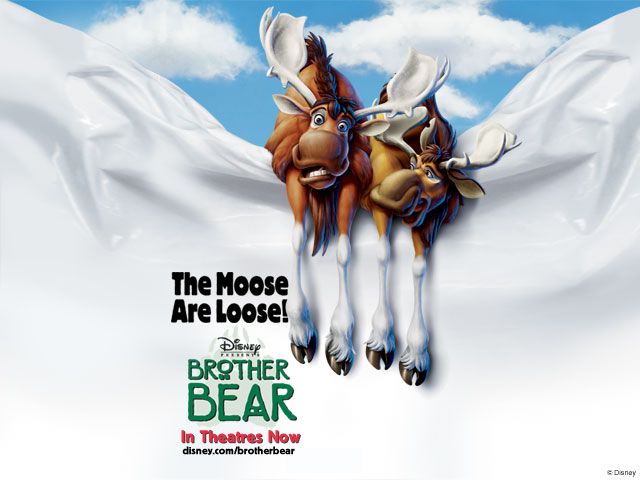
The latest animated feature from Disney -- an American Indian fable set in the Pacific Northwest during pre-Columbian times -- tries to follow a familiar Disney road, mixing humor and legend, but missing as often as it hits.
Brother Bear may leaven its story with enough cartoon antics to please younger audiences, but it feels far too calculated in its attempts to drive home its many points. In short, the name may be Disney, but the result falls short of a classic.
Friday, October 31, 2003
'Brother Bear' lacks the Disney magic
By WILLIAM ARNOLD
SEATTLE POST-INTELLIGENCER MOVIE CRITIC
The human characters are tepid, but the animals are imaginative and fun, especially a pair of moose modeled after SCTV's McKenzie Brothers (with the voices of that act's Rick Moranis and Dave Thomas) that are sure to find their way to a string of made-for-DVD sequels.
"Brother Bear" also has an unforced, pleasingly New Age feel to it; an unexpected but satisfying ending (a la "Shrek"); and a script that — despite its overdone, body-switching premise — comes together to nicely convey a cogent, environmentally conscious moral lesson.
Most critics mentioned the heavy-handed message, but no one mentioned the plot problems. But I bet they were reacting to the mess noted above whether they realized it or not. After all, many Disney movies have blatant messages—The Little Mermaid ("love conquers all") or The Lion King ("grow up and accept responsibility"). If the creators had presented their message with more subtlety and sophistication, Brother Bear could've been a classic.
Related links
The best Indian movies
"Marriage or bust" for Disney's women
Readers respond
"I would like to mention some thoughts of mine on the bad points."
"[T]he reason of my email is trying to 'redeem some of the bad points.'"
|
. . . |

|
All material © copyright its original owners, except where noted.
Original text and pictures © copyright 2007 by Robert Schmidt.
Copyrighted material is posted under the Fair Use provision of the Copyright Act,
which allows copying for nonprofit educational uses including criticism and commentary.
Comments sent to the publisher become the property of Blue Corn Comics
and may be used in other postings without permission.